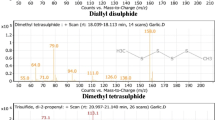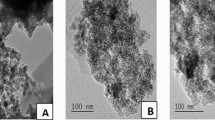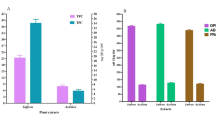Abstract
Essential oils of Ocimum basilicum (L.), Achillea fragrantissima (Forssk.) and Achillea santolina (L.) were obtained by hydrodistillation and analyzed using gas chromatography (GC) and GC/mass spectrometry (MS). Oil-in-water nanoemulsions (10% active ingredient) were prepared through a high-energy (ultrasonication) emulsification process. Nanoemulsions were characterized by viscosity, pH, thermodynamic stability, droplet size, polydispersity index (PDI) and scanning electron microscopy (SEM) measurements. The plant oils and their nanoemulsions showed considerable acaricidal activity against the mold mite, Tyrophagus putrescentiae (Schrank) (Sarcoptiformes: Acaridae). In a contact toxicity bioassay and 48 h post treatment, O. basilicum oil was the most toxic, followed by A. fragrantissima and A. santolina, where LC50 values were 8.4, 14.1 and 21.8 µl/cm2, respectively. LC50 for benzyl benzoate, a standard acaricide was 9.8 µl/cm2. Upon fumigation, responses also varied according to the test oil. Based on the 48-h LC50 values, the same manner of activity was also observed, where O. basilicum was the most toxic followed by A. fragrantissima and A. santolina. When prepared as nanoemulsions (particle size from 78.5 to 104.6) and tested as fumigants, toxicity of the oils was increased drastically with LC50 values of 2.2, 4.7, and 9.6 µl/l air for O. basilicum, A. fragrantissima and A. santolina, respectively. The oils showed a moderate to strong residual acaricidal activity, where O. basilicum oil was the most effective. The results suggest that appropriate nanoemulsions containing the tested oils can be developed to control T. putrescentiae after the required toxicological assessments.



Similar content being viewed by others
References
Abbott WS (1925) A method for computing the effectiveness of an insecticide. J Econ Entomol 18:265–267
Adams RP (2007) Identification of essential oil components by gas chromatography/mass spectrometry. Allured Publishing Corporation, Chicago
Al-Harbi KB, El-Ashmawy IM, Omar HM, Al-Wabel NA (2015) Anti-tick activity of some methanol-extracted plants indigenous in Saudi Arabia. J Anim Vet Adv 14(13):07–412
Almadiy A, Nenaah G, Al Assiuty B, Moussa E, Mira N (2016) Chemical composition and antibacterial activity of essential oils and major fractions of four Achillea species and their nanoemulsions against foodborne bacteria. LWT-Food Sci Technol 69:529–537
Almadiy A, Nenaah G, Shawer D (2018) Facile synthesis of silver nanoparticles using harmala alkaloids and their insecticidal and growth inhibitory activities against the khapra beetle. J Pest Sci 91(2):27–737
Anjali C, Sharma Y, Mukherjee A, Chandrasekaran N (2012) Neem oil (Azadirachta indica) nanoemulsion-a potent larvicidal agent against Culex quinquefasciatus. Pest Manag Sci 68:158–163
Arancibia C, Navarro-Lisboa R, Zúniga RN, Matiacevich S (2016) Application of CMC as thickener on nanoemulsions based on olive oil: physical properties and stability. Int J Polym Sci 2016:10
Assis CPO, Gondim MG, Siqueira HA, Câmara CA (2011) Toxicity of essential oils from plants towards Tyrophagus putrescentiae (Schrank) and Suidasia pontifica Oudemans (Acari: Astigmata). J Stored Prod Res 47(4):311–315
Badawy MEI, Saad A-FS, Tayeb E-SH, Mohammed SA, Abd-Elnabi AD (2017) Optimization and characterization of the formation of oil-in-water diazinon nanoemulsions: modeling and influence of the oil phase, surfactant and sonication. J Environ Sci Health, Part B 12:896–911
Badawy MEI, Abdelgaleil SAM, Mahmoud NF, Marei AM (2018) Preparation and characterizations of essential oil and monoterpene nanoemulsions and acaricidal activity against two-spotted spider mite (Tetranychus urticae Koch). Int J Acarol. https://doi.org/10.1080/01647954.2018.1523225
Bader A, Flamini G, Cioni PL, Morelli I (2003) Essential oil composition of Achillea santolina L. and Achillea biebersteinii Afan. collected in Jordon. Flav Frag J 18:36–38
Blenau W, Rademacher E, Baumann A (2012) Plant essential oils and formamidines as insecticides/acaricides: what are the molecular targets? Apidologie 43(3):334–347
Boczek J (1991) Mite pests in stored food. In: Gorham JR (ed) Ecology and Management of Food Industry Pest. FDA Technical Bulletin 4. Association of Official Analytical Chemists, Arlington, pp 57–79
Brazis P, Serra M, Selles A, Dethioux F, Biourge V, Puigdemont A (2008) Evaluation of storage mite contamination of commercial dry dog food. Vet Dermatol 4:209–214
Ebadollahi A (2017) Chemical composition, acaricidal and insecticidal effects of essential oil from Achillea filipendulina against two arthropod pests; Oryzaephilus surinamensis and Tetranychus urticae. Toxin Rev 36(2):132–137
Fernandes CP, de Almeida FB, Silveira AN, Gonzalez MS, Mello CB, Feder D, Apolinário R, Santos MG, Carvalho JCT, Tietbohl LAC (2014) Development of an insecticidal nanoemulsion with Manilkara subsericea (Sapotaceae) extract. J Nanobiotechnol 12:22–30
Franzolin MR, Gambale W, Cuero RG, Correa B (1999) Interaction between toxigenic Aspergillus flavus Link and mites (Tyrophagus putrescentiae Schrank) on maize grains: effects on fungal growth and aflatoxin production. J Stored Prod Res 35:215–224
Ghosh V, Mukherjee A, Chandrasekaran N (2013) Formulation and characterization of plant essential oil based nanoemulsion: evaluation of its larvicidal activity against Aedes aegypti. Asian J Chem 25(Supplementary Issue):S321–S323
Ghosh V, Mukherjee A, Chandrasekaran N (2014) Eugenol-loaded antimicrobial nanoemulsion preserves fruit juice against, microbial spoilage. Colloid Surf B 114:392–397
Gill C, McEwan N, McGarry J, Nuttal T (2011) House dust and storage mite contamination of dry dog food stored in open bags and sealed boxes in 10 domestic households. Vet Dermatol 22(2):162–172
Golemanov K, Tcholakova S, Denkov ND, Gurkov T (2006) Selection of surfactants for stable paraffin-in-water dispersions, undergoing solid-liquid transition of the dispersed particles. Langmuir 22(8):3560–3569
Hagstrum DW, Phillips TW, Cuperus G (2012) Stored product protection. Kansas State University Printing Services, Manhattan
Hoeller S, Sperger A, Valenta C (2009) Lecithin based nanoemulsions: a comparative study of the influence of non-ionic surfactants and the cationic phytosphingosine on physicochemical behaviour and skin permeation. Int J Pharm 370:181–186
Hüe T, Cauquil L, Fokou JB, Dongmo PM, Bakarnga-Via I, Menut C (2015) Acaricidal activity of five essential oils of Ocimum species on Rhipicephalus (Boophilus) microplus larvae. Parasitol Res 114(1):91–99
Hughes AM (1976) The mites of stored food and houses, 2nd edn. Ministry of Agriculture, Fisheries and Food, Technical Bulletin 9, London, p 400
Isman MB (2016) Pesticides based on plant essential oils: phytochemical and practical considerations. In: Jeliazkov VD, Cantrell CL (eds) Medicinal and aromatic crops: production, phytochemistry, and utilization. American Chemical Society, Washington, pp 13–26
Jeon JH, Lee CH, Lee HS (2009) Food protective effect of geraniol and its congeners against stored food mites. J Food Protect 72:1468–1471
Jeong EY, Lim JH, Kim HG, Lee HS (2008) Acaricidal activity of Thymus vulgaris oil and its main components against Tyrophagus putrescentiae, a stored food mite. J Food Prot 71(2):351–355
Khot L, Sankaran S, Maja J, Ehsani R, Schuster E (2012) Applications of nanomaterials in agricultural production and crop protection: a review. Crop Prot 35:64–70
Kim E-H, Kim H-K, Choi D-H, Ahn Y-J (2003a) Acaricidal activity of clove bud oil compounds against Tyrophagus putrescentiae (Acari: Acaridae). Appl Entomol Zool 38(2):261–266
Kim E-H, Kim H-K, Ahn Y-J (2003b) Acaricidal activity of plant essential oils against Tyrophagus putrescentiae (Acari: Acaridae). J Asia-Pac Entomol 6:77–82
Kim H-K, Kim J-R, Ahn Y-J (2004) Acaricidal activity of cinnamaldehyde and its congeners against Tyrophagus putrescentiae (Acari: Acaridae). J Stored Prod Res 40:55–63
Kwon JH, Ahn YJ (2002) Acaricidal activity of butylidenephthalide identified in Cnidium officinale rhizome against Dermatophagoides farinae and Dermatophagoides pteronyssinus (Acari: Pyroglyphidae). J Agric Food Chem 50:4479–4483
Lee C-H, Sung B-K, Lee H-S (2006) Acaricidal activity of fennel seed oils and their main components against Tyrophagus putrescentiae, a stored-food mite. J Stored Prod Res 42:8–14
Li PH, Chiang BH (2012) Process optimization and stability of D-limonene-in-water nanoemulsions prepared by ultrasonic emulsification using response surface methodology. Ultrason Sonochem 19:192–197
Macchioni F, Cioni PL, Flamini G, Morelli I, Perrucci S, Franceschi A, Macchioni G, Ceccarini L (2002) Acaricidal activity of pine essential oils and their main components against Tyrophagus putrescentiae, a stored food mite. J Agric Food Chem 50(16):4586–4588
Manzoor F, Fazal S, Munir N, Naz S, Khalid A (2013) Acaricidal Activity of Essential Oils from Tulsi (Ocimum basilicum), Bach (Acorus calamus) and Mint (Mentha arvensis) Against Rhipicephalus sanguineus (Latreille). Asian J Chem 25:6787–6790
Margulis-Goshen K, Magdassi S (2013) Nanotechnology: an advanced approach to the development of potent insecticides (A book chapter). In: Ishaaya I, Palli SR, Horowitz R (eds) Advanced technologies for managing insect pests. Springer, Dordrecht, pp 295–314
Matsumoto T, Hisano T, Hamaguchi M, Miike T (1996) Systemic anaphylaxis after eating storage-mite contaminated food. Int Arch Allergy Imm 109:197–200
Mohamed MI, Abdelgaleil SA (2008) Chemical composition and insecticidal potential of essential oils from Egyptian plants against Sitophilus oryzae (L.) (Coleoptera: Curculionidae) and Tribolium castaneum (Herbst) (Coleoptera: Tenebrionidae). Appl Entomol Zool 43(4):599–607
Mossa A, Afia S, Mohafrash S, Abou-Awad B (2018) Formulation and characterization of garlic (Allium sativum L) essential oil nanoemulsion and its acaricidal activity on eriophyid olive mites (Acari: Eriophyidae). Environ Sci Pollut 25(11):10526–10537
Mueller RS, Fieseler KV, Rosychuk RA, Greenwalt T (2005) Intradermal testing with the storage mite Tyrophagus putrescentiae in normal dogs and dogs with atopic dermatitis in Colorado. Vet Dermatol 16:27–31
Nenaah G (2014a) Bioactivity of powders and essential oils of three Asteraceae plants as post-harvest grain protectants against three major coleopteran pests. J Asia-Pac Entomol 17:701–709
Nenaah G (2014b) Chemical composition, insecticidal and repellence activities of essential oils of three Achillea species against the Khapra beetle (Coleoptera: Dermestidae). J Pest Sci 87(2):273–283
Nenaah G (2014c) Chemical composition, toxicity and growth inhibitory activities of essential oils of three Achillea species and their nano-emulsions against Tribolium castaneum (Herbst). Ind Crop Prod 53:252–260
Nenaah G, Ibrahim S (2011) Chemical composition and the insecticidal activity of certain plants applied as powders and essential oils against two stored-products coleopteran beetles. J Pest Sci 84:393–402
Nenaah G, Ibrahim S, Al-Assiuty B (2015) Chemical composition, insecticidal activity and persistence of three Asteraceae essential oils and their nanoemulsions against Callosobruchus maculatus (F.). J Stored Prod Res 61:9–16
Özcan M, Chalchat J-C (2002) Essential oil composition of Ocimum basilicum L. and Ocimum minimum L. in Turkey. Czech J Food Sci 20(6):223–228
Park J-H, Yang J-Y, Lee H-S (2014) Acaricidal activity of constituents derived from peppermint oil against Tyrophagus putrescentiae. J Food Prot 77(10):1819–1823
Reddy SR, Fogler HS (1981) Emulsion stability: determination from turbidity. J Colloid Interface Sci 79:101–104
Reiss H (1975) Entropy-induced dispersion of bulk liquids. J Colloid Interface Sci 53:61–70
Robertson EL (1959) A revision of the genus Tyrophagus with a discussion on its taxonomic position in the Acarina. Aust Zool 7:146–181
Sànchez-Ramos I, Castanera P (2001) Acaricidal activity of natural monoterpenes on Tyrophagus putrescentiae (Schrank), a mite of stored food. J Stored Prod Res 37:93
Sarapothong K, Pumnuan J, Insung A (2017) Acaricidal toxicity of nano essential oil of black pepper against African red mite (Eutetranychus africanus (Tucker). Int J Agric Technol 13(73):2267–2274
Sartoratto A, Lúcia A, Machado M, Delarmelina C, Figueira GM, Duarte MC, Rehder VL (2004) Composition and antimicrobial activity of essential oils from aromatic plants used in Brazil. Braz J Microbiol 35:275–280
SAS (Statistical Analysis System) Institute (1990) SAS/STAT User’s Guide, Version 6. SAS Institute, Cary
Shakeel F, Baboota S, Ahuja A, Ali J, Aqil M, Shafiq S (2007) Nanoemulsions as vehicles for transdermal delivery of aceclofenac. AAPS PharmSciTech 8(4):E104. https://doi.org/10.1208/pt0804104
Song JE, Kim JM, Lee NH, Yang JY, Lee HS (2016) Acaricidal and insecticidal activities of essential oils against a stored-food mite and stored-grain insects. J Food Prot 79(1):174–178
Stachurski J, Michalek M (1996) The effect of the z potential on the stability of a non polar oil-in-water emulsion. J Colloid Interface Sci 184:433–436
Stepanek P (1993) Data analysis in dynamic light scattering. In: Brown W (ed) Dynamic light scattering: the method and some applications. Clarendon Press, Oxford, pp 177–241
Sung B, Lim JH, Lee H (2006) Food protective and color alteration effects of acaricidal aldehydes on Tyrophagus putrescentiae (Schrank). J Food Prot 69(7):1728
Tadros T, Izquierdo P, Esquena J, Solans C (2004) Formation and stability of nano-emulsions. Adv Colloid Interface Sci 108–109:303–318
Taylor P (2003) Ostwald ripening in emulsions: estimation of solution thermodynamics of the disperse phase. Adv Colloid Interface Sci 106(1–3):261–285
Veeramani V, Sakthivelkumar S, Tamilarasan K, Aisha SO, Janarthanan S (2014) Acaricidal activity of Ocimum basilicum and Spilanthes acmella against the ectoparasitic tick, Rhipicephalus (Boophilus) microplus (Arachinida: Ixodidae). Trop Biomed 31(3):414–421
Weiss J, Takhistov P, McClements JD (2006) Functional materials in food nanotechnology. J Food Sci 71:107–116
Acknowledgements
The authors thank Prof. Dr. Abdel Naieem Al-Assuity for the identification and authentication of the mite species.
Author information
Authors and Affiliations
Contributions
GN and BA conceived and designed the experiments. All authors conducted bioassays. GN achieved GC–Ms. All authors collected and analyzed data. GN and BA wrote the manuscript. All read and approved manuscript.
Corresponding author
Ethics declarations
Conflict of interest
The authors declare that they have no conflict of interest.
Ethical approval
All applicable international, national, and/or institutional guidelines for the care and use of animals were followed. This article does not contain any studies with human participants performed by any of the authors.
Additional information
Publisher's Note
Springer Nature remains neutral with regard to jurisdictional claims in published maps and institutional affiliations.
Rights and permissions
About this article
Cite this article
Al-Assiuty, B.A., Nenaah, G.E. & Ageba, M.E. Chemical profile, characterization and acaricidal activity of essential oils of three plant species and their nanoemulsions against Tyrophagus putrescentiae, a stored-food mite. Exp Appl Acarol 79, 359–376 (2019). https://doi.org/10.1007/s10493-019-00432-x
Received:
Accepted:
Published:
Issue Date:
DOI: https://doi.org/10.1007/s10493-019-00432-x




